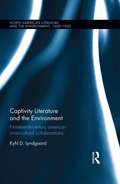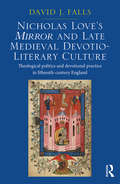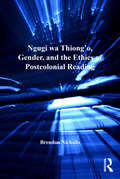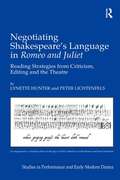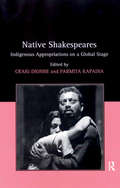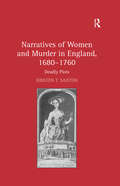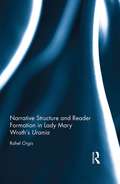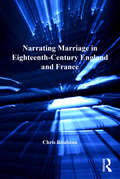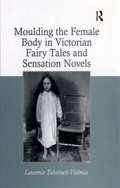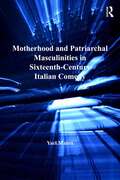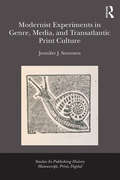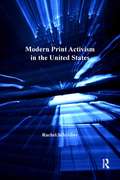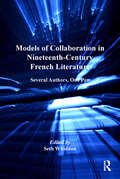- Table View
- List View
Captivity Literature and the Environment: Nineteenth-Century American Cross-Cultural Collaborations (Routledge Studies in World Literatures and the Environment)
by Kyhl D. LyndgaardIn his study of captivity narratives, Kyhl Lyndgaard argues that these accounts have influenced land-use policy and environmental attitudes at the same time that they reveal the complex relationship between ethnicity, landscape, and authorship. In connecting these themes, Lyndgaard offers readers an alternative environmental literature, one that is dependent on an understanding of nature as home rather than as a place of temporary retreat. He examines three captivity narratives written in the 1820s and 1830s - A Narrative of the Life of Mrs. Mary Jemison, The Captivity and Adventures of John Tanner, and Life of Black Hawk -all of which engage with the Jacksonian policy of Indian removal and resist tropes of the so-called Vanishing Indian. As Lyndgaard shows, the authors and the editors with whom they collaborated often saw their stories as a plea for environmental and social justice. At the same time, audiences have embraced them for their vision of a more inclusive and less exploitative American society than was proffered by the rhetoric of Manifest Destiny. Their legacy is that while environmental and social justice has been slow in fulfilment, their continued popularity testifies to the fact that the struggle for justice has never been ceded.
Captivity Literature and the Environment: Nineteenth-Century American Cross-Cultural Collaborations (Routledge Studies in World Literatures and the Environment)
by Kyhl D. LyndgaardIn his study of captivity narratives, Kyhl Lyndgaard argues that these accounts have influenced land-use policy and environmental attitudes at the same time that they reveal the complex relationship between ethnicity, landscape, and authorship. In connecting these themes, Lyndgaard offers readers an alternative environmental literature, one that is dependent on an understanding of nature as home rather than as a place of temporary retreat. He examines three captivity narratives written in the 1820s and 1830s - A Narrative of the Life of Mrs. Mary Jemison, The Captivity and Adventures of John Tanner, and Life of Black Hawk -all of which engage with the Jacksonian policy of Indian removal and resist tropes of the so-called Vanishing Indian. As Lyndgaard shows, the authors and the editors with whom they collaborated often saw their stories as a plea for environmental and social justice. At the same time, audiences have embraced them for their vision of a more inclusive and less exploitative American society than was proffered by the rhetoric of Manifest Destiny. Their legacy is that while environmental and social justice has been slow in fulfilment, their continued popularity testifies to the fact that the struggle for justice has never been ceded.
Nicholas Love's Mirror and Late Medieval Devotio-Literary Culture: Theological politics and devotional practice in fifteenth-century England
by David J. FallsSurviving in 59 complete manuscript versions, few English texts of the late medieval period seem to have achieved the popularity of Nicholas Love's fifteenth-century translation and adaptation of the Latin Meditationes Vitae Christi - The Mirror of the Blessed Life of Jesus Christ. The Mirror has received surprisingly little scholarly attention and is often contextualized in terms of its role in the theological conflict between English ecclesiastical orthodoxy and the teachings of heresiarch John Wycliff. David Falls presents a new account of the text's history which de-centralises, but does not disregard, the influence of the Wycliffite controversy. Falls interrogates preconceptions and investigates new possibilities for understanding the composition, circulation, function and use of Love's Mirror by examining both the textual modifications and additions made by Love in his adaptation of the Latin, and places these alterations in context by examining individual copies of the Mirror. The manuscript copies are read as both sites of literary consumption and nexuses of textual transition, demonstrating that it was Love's ability to inscribe his work with "functional diversity" which explains the Mirror's popularity. This book presents a nuanced picture not only of the Mirror's production, circulation and function, but also the dynamic and flourishing devotio-literary culture of late medieval England in which Love's text operated.
Nicholas Love's Mirror and Late Medieval Devotio-Literary Culture: Theological politics and devotional practice in fifteenth-century England
by David J. FallsSurviving in 59 complete manuscript versions, few English texts of the late medieval period seem to have achieved the popularity of Nicholas Love's fifteenth-century translation and adaptation of the Latin Meditationes Vitae Christi - The Mirror of the Blessed Life of Jesus Christ. The Mirror has received surprisingly little scholarly attention and is often contextualized in terms of its role in the theological conflict between English ecclesiastical orthodoxy and the teachings of heresiarch John Wycliff. David Falls presents a new account of the text's history which de-centralises, but does not disregard, the influence of the Wycliffite controversy. Falls interrogates preconceptions and investigates new possibilities for understanding the composition, circulation, function and use of Love's Mirror by examining both the textual modifications and additions made by Love in his adaptation of the Latin, and places these alterations in context by examining individual copies of the Mirror. The manuscript copies are read as both sites of literary consumption and nexuses of textual transition, demonstrating that it was Love's ability to inscribe his work with "functional diversity" which explains the Mirror's popularity. This book presents a nuanced picture not only of the Mirror's production, circulation and function, but also the dynamic and flourishing devotio-literary culture of late medieval England in which Love's text operated.
Ngugi wa Thiong’o, Gender, and the Ethics of Postcolonial Reading
by Brendon NichollsThis is the first comprehensive book-length study of gender politics in Ngugi wa Thiong'o's fiction. Brendon Nicholls argues that mechanisms of gender subordination are strategically crucial to Ngugi's ideological project from his first novel to his most recent one. Nicholls describes the historical pressures that lead Ngugi to represent women as he does, and shows that the novels themselves are symptomatic of the cultural conditions that they address. Reading Ngugi's fiction in terms of its Gikuyu allusions and references, a gendered narrative of history emerges that creates transgressive spaces for women. Nicholls bases his discussion on moments during the Mau Mau rebellion when women's contributions to the anticolonial struggle could not be reduced to a patriarchal narrative of Kenyan history, and this interpretive maneuver permits a reading of Ngugi's fiction that accommodates female political and sexual agency. Nicholls contributes to postcolonial theory by proposing a methodology for reading cultural difference. This methodology critiques cultural practices like clitoridectomy in an ethical manner that seeks to avoid both cultural imperialism and cultural relativisim. His strategy of 'performative reading,' that is, making the conditions of one text (such as folklore, history, or translation) active in another (for example, fiction, literary narrative, or nationalism), makes possible an ethical reading of gender and of the conditions of reading in translation.
Ngugi wa Thiong’o, Gender, and the Ethics of Postcolonial Reading
by Brendon NichollsThis is the first comprehensive book-length study of gender politics in Ngugi wa Thiong'o's fiction. Brendon Nicholls argues that mechanisms of gender subordination are strategically crucial to Ngugi's ideological project from his first novel to his most recent one. Nicholls describes the historical pressures that lead Ngugi to represent women as he does, and shows that the novels themselves are symptomatic of the cultural conditions that they address. Reading Ngugi's fiction in terms of its Gikuyu allusions and references, a gendered narrative of history emerges that creates transgressive spaces for women. Nicholls bases his discussion on moments during the Mau Mau rebellion when women's contributions to the anticolonial struggle could not be reduced to a patriarchal narrative of Kenyan history, and this interpretive maneuver permits a reading of Ngugi's fiction that accommodates female political and sexual agency. Nicholls contributes to postcolonial theory by proposing a methodology for reading cultural difference. This methodology critiques cultural practices like clitoridectomy in an ethical manner that seeks to avoid both cultural imperialism and cultural relativisim. His strategy of 'performative reading,' that is, making the conditions of one text (such as folklore, history, or translation) active in another (for example, fiction, literary narrative, or nationalism), makes possible an ethical reading of gender and of the conditions of reading in translation.
Negotiating Shakespeare's Language in Romeo and Juliet: Reading Strategies from Criticism, Editing and the Theatre (Studies in Performance and Early Modern Drama)
by Lynette Hunter Peter LichtenfelsThrough exciting and unconventional approaches, including critical/historical, printing/publishing and performance studies, this study mines Shakespeare's Romeo and Juliet to produce new insights into the early modern family, the individual, and society in the context of early modern capitalism. Inspired by recent work in cultural materialism and the material book, it also foregrounds the ways in which the contexts and the text itself become available to the reader today. The opening material on critical/historical approaches focuses on the way that readers have frequently read and played the text to explore issues that cluster around the family, marriage, gender and sexuality. Chapter two, on the ways that actors today inhabit character and create behaviour, provides intertextual comment on acting in the early modern period, and the connections between acting and social behaviour that inform self-image and the performance of identity both then and now. The third chapter on printing/publishing approaches to the text offers a detective story about the differences between Quarto One and Quarto Two, that focuses on the curious appearance in Quarto Two of material related to the law at word, phrase, line and scene level. The next three chapters integrate a close study of the language of the play to negotiate its potential significance for the present in the areas of: Family, Marriage, Gender and Sexuality; Identity, Individualism and Humanism; and the Law, Religion and Medicine. Among the startling aspects of this book are that it: - takes the part of Juliet far more seriously than other criticism has tended to do, attributing to her agency and aspects of character that develop the part suddenly from girl to woman; - recognizes the way the play explores early modern identity, becoming a handbook for individualism and humanism in the private domestic setting of early capitalism; and - brings to light the least recognized element in the play at the moment, its demonstration of the emerging structures of state power, governance by law, the introduction of surveillance, detection and witness, and the formation of what we now call the 'subject'. The volume includes on DVD a scholarly edition with commentary of the text of Romeo & Juliet, which re-instates many of the original early modern versions of the play.
Negotiating Shakespeare's Language in Romeo and Juliet: Reading Strategies from Criticism, Editing and the Theatre (Studies in Performance and Early Modern Drama)
by Lynette Hunter Peter LichtenfelsThrough exciting and unconventional approaches, including critical/historical, printing/publishing and performance studies, this study mines Shakespeare's Romeo and Juliet to produce new insights into the early modern family, the individual, and society in the context of early modern capitalism. Inspired by recent work in cultural materialism and the material book, it also foregrounds the ways in which the contexts and the text itself become available to the reader today. The opening material on critical/historical approaches focuses on the way that readers have frequently read and played the text to explore issues that cluster around the family, marriage, gender and sexuality. Chapter two, on the ways that actors today inhabit character and create behaviour, provides intertextual comment on acting in the early modern period, and the connections between acting and social behaviour that inform self-image and the performance of identity both then and now. The third chapter on printing/publishing approaches to the text offers a detective story about the differences between Quarto One and Quarto Two, that focuses on the curious appearance in Quarto Two of material related to the law at word, phrase, line and scene level. The next three chapters integrate a close study of the language of the play to negotiate its potential significance for the present in the areas of: Family, Marriage, Gender and Sexuality; Identity, Individualism and Humanism; and the Law, Religion and Medicine. Among the startling aspects of this book are that it: - takes the part of Juliet far more seriously than other criticism has tended to do, attributing to her agency and aspects of character that develop the part suddenly from girl to woman; - recognizes the way the play explores early modern identity, becoming a handbook for individualism and humanism in the private domestic setting of early capitalism; and - brings to light the least recognized element in the play at the moment, its demonstration of the emerging structures of state power, governance by law, the introduction of surveillance, detection and witness, and the formation of what we now call the 'subject'. The volume includes on DVD a scholarly edition with commentary of the text of Romeo & Juliet, which re-instates many of the original early modern versions of the play.
Native Shakespeares: Indigenous Appropriations on a Global Stage
by Parmita KapadiaExplored in this essay collection is how Shakespeare is rewritten, reinscribed and translated to fit within the local tradition, values, and languages of the world's various communities and cultures. Contributors show that Shakespeare, regardless of the medium - theater, pedagogy, or literary studies - is commonly 'rooted' in the local customs of a people in ways that challenge the notion that his drama promotes a Western idealism. Native Shakespeares examines how the persistent indigenization of Shakespeare complicates the traditional vision of his work as a voice of Western culture and colonial hegemony. The international range of the collection and the focus on indigenous practices distinguishes Native Shakespeares from other available texts.
Native Shakespeares: Indigenous Appropriations on a Global Stage
by Parmita KapadiaExplored in this essay collection is how Shakespeare is rewritten, reinscribed and translated to fit within the local tradition, values, and languages of the world's various communities and cultures. Contributors show that Shakespeare, regardless of the medium - theater, pedagogy, or literary studies - is commonly 'rooted' in the local customs of a people in ways that challenge the notion that his drama promotes a Western idealism. Native Shakespeares examines how the persistent indigenization of Shakespeare complicates the traditional vision of his work as a voice of Western culture and colonial hegemony. The international range of the collection and the focus on indigenous practices distinguishes Native Shakespeares from other available texts.
Narratives of Women and Murder in England, 1680–1760: Deadly Plots
by Kirsten T. SaxtonArguing that the female criminal subject was central to the rise of the British novel, Kirsten T. Saxton provides fresh and convincing insights into the deeply complex ways in which categories of criminality, gender, and fiction intersected in the long eighteenth century. She offers the figure of the murderess as evidence of the constitutive relationship between eighteenth-century legal and fictional texts, comparing non-fiction representations of homicidal women in biographies of Newgate Ordinaries and in trial reports with those in the early novels of Aphra Behn, Delariviere Manley, Daniel Defoe, and Henry Fielding. As Saxton demonstrates that legal narratives informed the budding genre of the novel and fictional texts shaped the development of legal narratives, her study of deadly plots becomes a feminist intervention in scholarship on the literature of crime that simultaneously insists on the centrality of crime literature in feminist histories of the novel. Her epilogue shows that more than two centuries later, we still contend with displays of female violence that defy and define our notions of textual and sexual license and continue to shape legal and literary mandates, even as the lines between the real and the fictive remain blurred.
Narratives of Women and Murder in England, 1680–1760: Deadly Plots
by Kirsten T. SaxtonArguing that the female criminal subject was central to the rise of the British novel, Kirsten T. Saxton provides fresh and convincing insights into the deeply complex ways in which categories of criminality, gender, and fiction intersected in the long eighteenth century. She offers the figure of the murderess as evidence of the constitutive relationship between eighteenth-century legal and fictional texts, comparing non-fiction representations of homicidal women in biographies of Newgate Ordinaries and in trial reports with those in the early novels of Aphra Behn, Delariviere Manley, Daniel Defoe, and Henry Fielding. As Saxton demonstrates that legal narratives informed the budding genre of the novel and fictional texts shaped the development of legal narratives, her study of deadly plots becomes a feminist intervention in scholarship on the literature of crime that simultaneously insists on the centrality of crime literature in feminist histories of the novel. Her epilogue shows that more than two centuries later, we still contend with displays of female violence that defy and define our notions of textual and sexual license and continue to shape legal and literary mandates, even as the lines between the real and the fictive remain blurred.
Narrative Structure and Reader Formation in Lady Mary Wroth's Urania
by Rahel OrgisNarrative Structure and Reader Formation in Lady Mary Wroth’s Urania offers the first systematic formal and thematic analysis of Wroth’s Urania in its historical context and explores the structural means by which Wroth fashions her readership. The book thus has a dual focus, at once on narrative art and reader formation. It makes two original claims, the first being that the Urania is not the unorganized accumulation of stories critics have tended to present it as, but a work of sophisticated narrative structures i.e. a complex text in a positive sense. These structures are revealed by means of a circumspect narratological analysis of the formal and thematic patterns that organise the Urania. Such an analysis furthers our understanding of the reading strategies that Wroth encourages. The second claim is, then, that through the careful structuring of her text Wroth seeks to create her own ideal readership. More precisely, the formal and thematic structures of the Urania engage with readers’ expectations, inviting them to reflect on prominent thematic issues and respond to the text as what early modern prefaces term "good" readers. Combining narratological methods with a generic perspective and taking into account the work of book historians on early modern reading practices, this monograph provides a new approach to the Urania, supplementing the typically gender- or (auto)biographically-oriented interpretations of the romance. Moreover, it contributes to the study of early modern (prose) narrative and romance and exemplifies how historically contextualised narratological analysis may yield new insights and profit research on reading strategies.
Narrative Structure and Reader Formation in Lady Mary Wroth's Urania
by Rahel OrgisNarrative Structure and Reader Formation in Lady Mary Wroth’s Urania offers the first systematic formal and thematic analysis of Wroth’s Urania in its historical context and explores the structural means by which Wroth fashions her readership. The book thus has a dual focus, at once on narrative art and reader formation. It makes two original claims, the first being that the Urania is not the unorganized accumulation of stories critics have tended to present it as, but a work of sophisticated narrative structures i.e. a complex text in a positive sense. These structures are revealed by means of a circumspect narratological analysis of the formal and thematic patterns that organise the Urania. Such an analysis furthers our understanding of the reading strategies that Wroth encourages. The second claim is, then, that through the careful structuring of her text Wroth seeks to create her own ideal readership. More precisely, the formal and thematic structures of the Urania engage with readers’ expectations, inviting them to reflect on prominent thematic issues and respond to the text as what early modern prefaces term "good" readers. Combining narratological methods with a generic perspective and taking into account the work of book historians on early modern reading practices, this monograph provides a new approach to the Urania, supplementing the typically gender- or (auto)biographically-oriented interpretations of the romance. Moreover, it contributes to the study of early modern (prose) narrative and romance and exemplifies how historically contextualised narratological analysis may yield new insights and profit research on reading strategies.
Narrating Marriage in Eighteenth-Century England and France
by Chris RoulstonIn the eighteenth century, when the definition of marriage was shifting from one based on an hierarchical model to one based on notions of love and mutuality, marital life came under a more intense cultural scrutiny. This led to paradoxical forms of representation of marriage as simultaneously ideal and unlivable. Chris Roulston analyzes how, as representations of married life increased, they challenged the traditional courtship model, offering narratives based on repetition rather than progression. Beginning with English and French marital advice literature, which appropriated novelistic conventions at the same time that it cautioned readers about the dangers of novel reading, she looks at representations of ideal marriages in Pamela II and The New Heloise. Moving on from these ideal domestic spaces, bourgeois marriage is then problematized by the discourse of empire in Sir George Ellison and Letters of Mistress Henley, by troublesome wives in works by Richardson and Samuel de Constant, and by abusive husbands in works by Haywood, Edgeworth, Genlis and Restif de la Bretonne. Finally, the alternative marriage narrative, in which the adultery motif is incorporated into the marriage itself, redefines the function of heteronormativity. In exploring the theoretical issues that arise during this transitional period for married life and the marriage plot, Roulston expands the debates around the evolution of the modern couple.
Narrating Marriage in Eighteenth-Century England and France
by Chris RoulstonIn the eighteenth century, when the definition of marriage was shifting from one based on an hierarchical model to one based on notions of love and mutuality, marital life came under a more intense cultural scrutiny. This led to paradoxical forms of representation of marriage as simultaneously ideal and unlivable. Chris Roulston analyzes how, as representations of married life increased, they challenged the traditional courtship model, offering narratives based on repetition rather than progression. Beginning with English and French marital advice literature, which appropriated novelistic conventions at the same time that it cautioned readers about the dangers of novel reading, she looks at representations of ideal marriages in Pamela II and The New Heloise. Moving on from these ideal domestic spaces, bourgeois marriage is then problematized by the discourse of empire in Sir George Ellison and Letters of Mistress Henley, by troublesome wives in works by Richardson and Samuel de Constant, and by abusive husbands in works by Haywood, Edgeworth, Genlis and Restif de la Bretonne. Finally, the alternative marriage narrative, in which the adultery motif is incorporated into the marriage itself, redefines the function of heteronormativity. In exploring the theoretical issues that arise during this transitional period for married life and the marriage plot, Roulston expands the debates around the evolution of the modern couple.
Moulding the Female Body in Victorian Fairy Tales and Sensation Novels
by Laurence Talairach-VielmasLaurence Talairach-Vielmas explores Victorian representations of femininity in narratives that depart from mainstream realism, from fairy tales by George MacDonald, Lewis Carroll, Christina Rossetti, Juliana Horatia Ewing, and Jean Ingelow, to sensation novels by Wilkie Collins, Mary Elizabeth Braddon, Rhoda Broughton, and Charles Dickens. Feminine representation, Talairach-Vielmas argues, is actually presented in a hyper-realistic way in such anti-realistic genres as children's literature and sensation fiction. In fact, it is precisely the clash between fantasy and reality that enables the narratives to interrogate the real and re-create a new type of realism that exposes the normative constraints imposed to contain the female body. In her exploration of the female body and its representations, Talairach-Vielmas examines how Victorian fantasies and sensation novels deconstruct and reconstruct femininity; she focuses in particular on the links between the female characters and consumerism, and shows how these serve to illuminate the tensions underlying the representation of the Victorian ideal.
Moulding the Female Body in Victorian Fairy Tales and Sensation Novels
by Laurence Talairach-VielmasLaurence Talairach-Vielmas explores Victorian representations of femininity in narratives that depart from mainstream realism, from fairy tales by George MacDonald, Lewis Carroll, Christina Rossetti, Juliana Horatia Ewing, and Jean Ingelow, to sensation novels by Wilkie Collins, Mary Elizabeth Braddon, Rhoda Broughton, and Charles Dickens. Feminine representation, Talairach-Vielmas argues, is actually presented in a hyper-realistic way in such anti-realistic genres as children's literature and sensation fiction. In fact, it is precisely the clash between fantasy and reality that enables the narratives to interrogate the real and re-create a new type of realism that exposes the normative constraints imposed to contain the female body. In her exploration of the female body and its representations, Talairach-Vielmas examines how Victorian fantasies and sensation novels deconstruct and reconstruct femininity; she focuses in particular on the links between the female characters and consumerism, and shows how these serve to illuminate the tensions underlying the representation of the Victorian ideal.
Motherhood and Patriarchal Masculinities in Sixteenth-Century Italian Comedy
by Yael ManesExploring individual and collective formation of gender identities, this book contributes to current scholarly discourses by examining plays in the genre of 'erudite comedy' (commedia erudita), which was extremely popular among sixteenth-century Italians from the elite classes. Author Yael Manes investigates five erudite comedies-Ludovico Ariosto's I suppositi (1509), Niccolò Machiavelli's La Mandragola (1518) and Clizia (1525), Antonio Landi's Il commodo (1539), and Giovan Maria Cecchi's La stiava (1546)-to consider how erudite comedies functioned as ideological battlefields where the gender system of patriarchy was examined, negotiated, and critiqued. These plays reflect the patriarchal order of their elite social milieu, but they also offer a unique critical vantage point on the paradoxical formation of patriarchal masculinity. On the one hand, patriarchal ideology rejects the mother and forbids her as an object of desire; on the other hand, patriarchal male identity revolves around representations of motherhood. Ultimately, the comedies reflect the desire of the Italian Renaissance male elite for women who will provide children to their husbands but not actively assume the role of a mother. In sum, Manes reveals a wide cultural understanding that motherhood-as an activity that women undertake, not simply a relational position they occupy-challenges patriarchy because it bestows women with agency, power, and authority. Manes here recovers the complexity of Renaissance Italian discourse on gender and identity formation by approaching erudite comedies not only as mirrors of their audiences but also as vehicles for contemporary audiences' ideological, psychological, and emotional expressions.
Motherhood and Patriarchal Masculinities in Sixteenth-Century Italian Comedy
by Yael ManesExploring individual and collective formation of gender identities, this book contributes to current scholarly discourses by examining plays in the genre of 'erudite comedy' (commedia erudita), which was extremely popular among sixteenth-century Italians from the elite classes. Author Yael Manes investigates five erudite comedies-Ludovico Ariosto's I suppositi (1509), Niccolò Machiavelli's La Mandragola (1518) and Clizia (1525), Antonio Landi's Il commodo (1539), and Giovan Maria Cecchi's La stiava (1546)-to consider how erudite comedies functioned as ideological battlefields where the gender system of patriarchy was examined, negotiated, and critiqued. These plays reflect the patriarchal order of their elite social milieu, but they also offer a unique critical vantage point on the paradoxical formation of patriarchal masculinity. On the one hand, patriarchal ideology rejects the mother and forbids her as an object of desire; on the other hand, patriarchal male identity revolves around representations of motherhood. Ultimately, the comedies reflect the desire of the Italian Renaissance male elite for women who will provide children to their husbands but not actively assume the role of a mother. In sum, Manes reveals a wide cultural understanding that motherhood-as an activity that women undertake, not simply a relational position they occupy-challenges patriarchy because it bestows women with agency, power, and authority. Manes here recovers the complexity of Renaissance Italian discourse on gender and identity formation by approaching erudite comedies not only as mirrors of their audiences but also as vehicles for contemporary audiences' ideological, psychological, and emotional expressions.
Modernist Experiments in Genre, Media, and Transatlantic Print Culture (Studies in Publishing History: Manuscript, Print, Digital)
by Jennifer Julia SorensenThe years from 1890 through 1935 witnessed an explosion of print, both in terms of the variety of venues for publication and in the vast circulation figures and the quantity of print forums. Arguing that the formal strategies of modernist texts can only be fully understood in the context of the material forms and circuits of print culture through which they were produced and distributed, Jennifer Sorensen shows how authors and publishers conceptualized the material text as an object, as a body, and as an ontological problem. She examines works by Henry James, Jean Toomer, Djuna Barnes, Katherine Mansfield, and Virginia Woolf, showing that they understood acts of reading as materially mediated encounters. Sorensen draws on recent textual theory, media theory, archival materials, and paratexts such as advertisements, illustrations, book designs, drafts, diaries, dust jackets, notes, and frontispieces, to demonstrate how these writers radically redefined literary genres and refashioned the material forms through which their literary experiments reached the public. Placing the literary text at the center of inquiry while simultaneously expanding the boundaries of what counts as that, Sorensen shows that modernist generic and formal experimentation was deeply engaged with specific print histories that generated competitive media ecologies of competition and hybridization.
Modernist Experiments in Genre, Media, and Transatlantic Print Culture (Studies in Publishing History: Manuscript, Print, Digital)
by Jennifer Julia SorensenThe years from 1890 through 1935 witnessed an explosion of print, both in terms of the variety of venues for publication and in the vast circulation figures and the quantity of print forums. Arguing that the formal strategies of modernist texts can only be fully understood in the context of the material forms and circuits of print culture through which they were produced and distributed, Jennifer Sorensen shows how authors and publishers conceptualized the material text as an object, as a body, and as an ontological problem. She examines works by Henry James, Jean Toomer, Djuna Barnes, Katherine Mansfield, and Virginia Woolf, showing that they understood acts of reading as materially mediated encounters. Sorensen draws on recent textual theory, media theory, archival materials, and paratexts such as advertisements, illustrations, book designs, drafts, diaries, dust jackets, notes, and frontispieces, to demonstrate how these writers radically redefined literary genres and refashioned the material forms through which their literary experiments reached the public. Placing the literary text at the center of inquiry while simultaneously expanding the boundaries of what counts as that, Sorensen shows that modernist generic and formal experimentation was deeply engaged with specific print histories that generated competitive media ecologies of competition and hybridization.
Modern Print Activism in the United States
by Rachel SchreiberThe explosion of print culture that occurred in the United States at the turn of the twentieth century activated the widespread use of print media to promote social and political activism. Exploring this phenomenon, the essays in Modern Print Activism in the United States focus on specific groups, individuals, and causes that relied on print as a vehicle for activism. They also take up the variety of print forms in which calls for activism have appeared, including fiction, editorials, letters to the editor, graphic satire, and non-periodical media such as pamphlets and calendars. As the contributors show, activists have used print media in a range of ways, not only in expected applications such as calls for boycotts and protests, but also for less expected aims such as the creation of networks among readers and to the legitimization of their causes. At a time when the golden age of print appears to be ending, Modern Print Activism in the United States argues that print activism should be studied as a specifically modernist phenomenon and poses questions related to the efficacy of print as a vehicle for social and political change.
Modern Print Activism in the United States
by Rachel SchreiberThe explosion of print culture that occurred in the United States at the turn of the twentieth century activated the widespread use of print media to promote social and political activism. Exploring this phenomenon, the essays in Modern Print Activism in the United States focus on specific groups, individuals, and causes that relied on print as a vehicle for activism. They also take up the variety of print forms in which calls for activism have appeared, including fiction, editorials, letters to the editor, graphic satire, and non-periodical media such as pamphlets and calendars. As the contributors show, activists have used print media in a range of ways, not only in expected applications such as calls for boycotts and protests, but also for less expected aims such as the creation of networks among readers and to the legitimization of their causes. At a time when the golden age of print appears to be ending, Modern Print Activism in the United States argues that print activism should be studied as a specifically modernist phenomenon and poses questions related to the efficacy of print as a vehicle for social and political change.
Models of Collaboration in Nineteenth-Century French Literature: Several Authors, One Pen
by Seth WhiddenContributing to the current lively discussion of collaboration in French letters, this collection raises fundamental questions about the limits and definition of authorship in the context of the nineteenth century's explosion of collaborative ventures. While the model of the stable single author that prevailed during the Romantic period dominates the beginning of the century, the authority of the speaking subject is increasingly in crisis through the century's political and social upheavals. Chapters consider the breakdown of authorial presence across different constructions of authorship, including the numerous cenacles of the Romantic period; collaborative ventures in poetry through the practice of the "Tombeaux" and as seen in the Album zutique; the interplay of text and image through illustrations for literary works; the collective ventures of literary journals; and multi-author prose works by authors such as the Goncourt brothers and Erckmann-Chatrian. Interdisciplinary in scope, these essays form a cohesive investigation of collaboration that extends beyond literature to include journalism and the relationships and tensions between literature and the arts. The volume will interest scholars of nineteenth-century French literature, and more generally, any scholar interested in what's at stake in redefining the role of the French author
